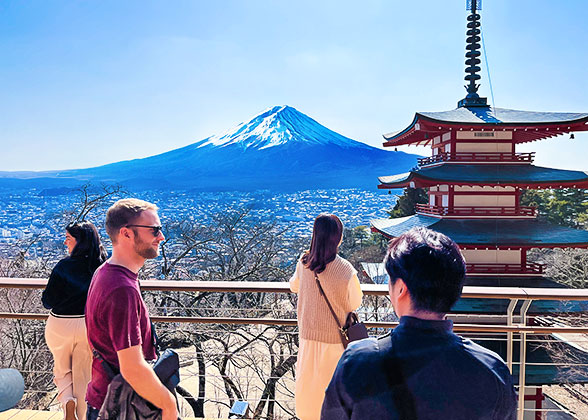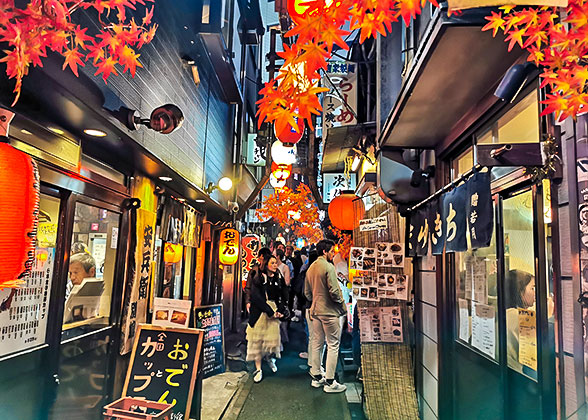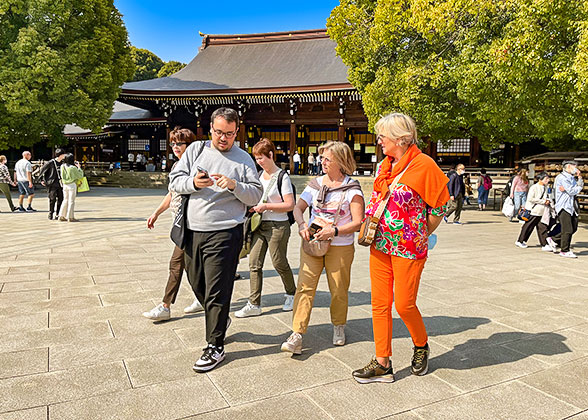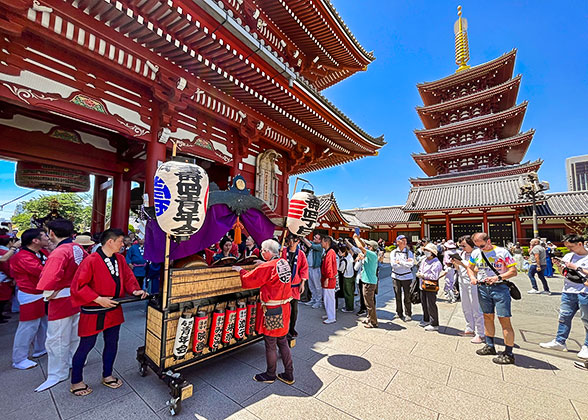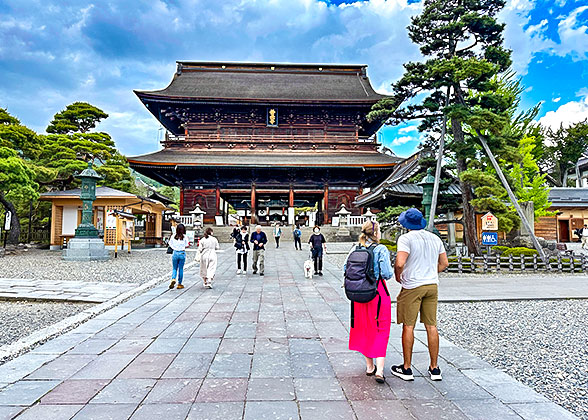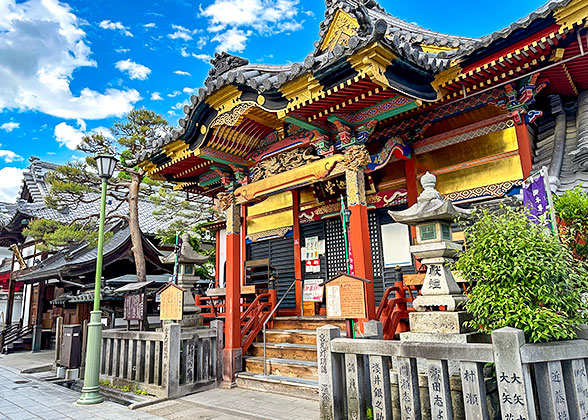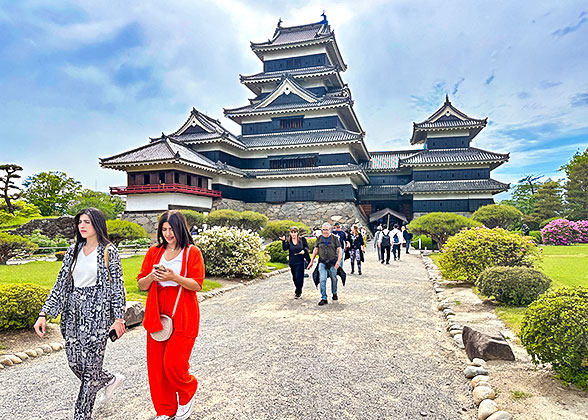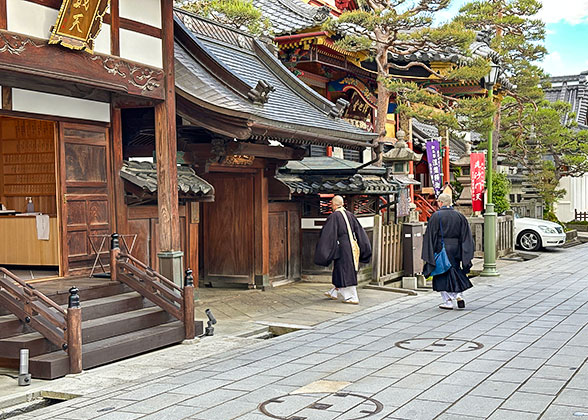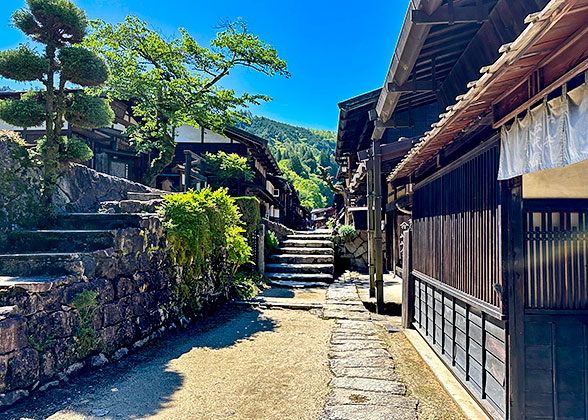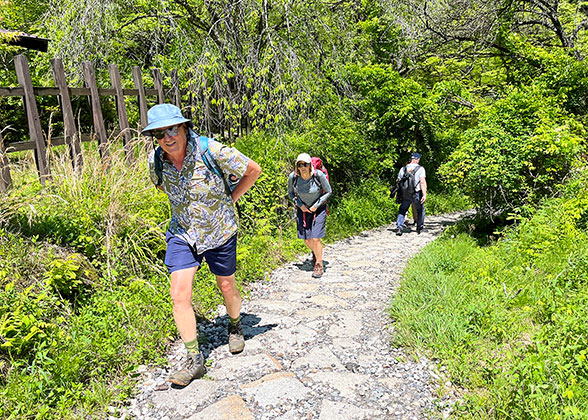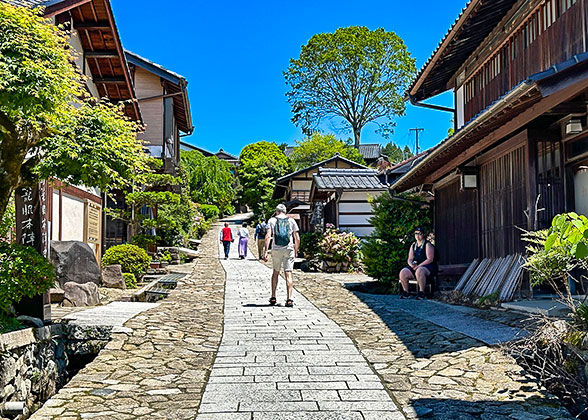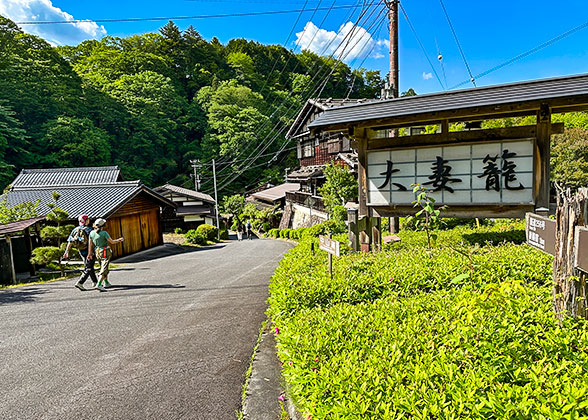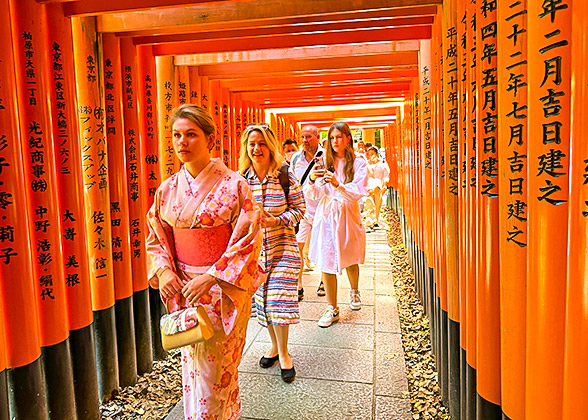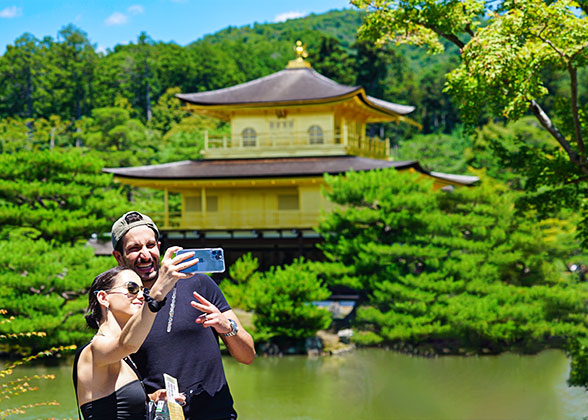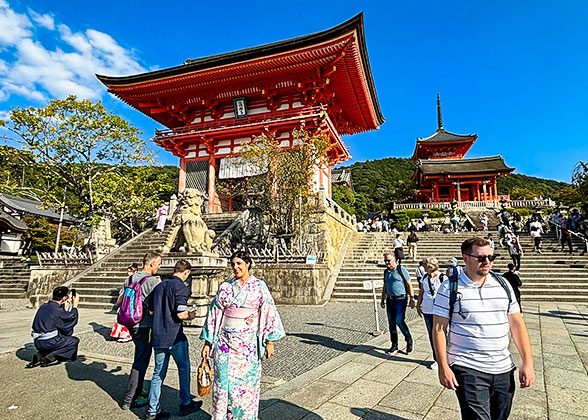Day 1: Arrive in Tokyo; Airport Pick-up
Welcome to choose this Japan tour full of scenic sites and cultural delights. When your flight arrives at Tokyo, our English-speaking assistant will be ready to serve you and guide you to the shared car we have already reserved for you, which will take you directly to the hotel. Check into the hotel handpicked by our hotel test team and you’ll have a good sleep and be ready for the following wonderful Japan tour.
Accommodation: Hotel Century Southern Tower (4 stars) in Tokyo
|
Day 2: Mt. Fuji & Lake Kawaguchi
Today is the highlight of this trip. Tick off your Japan bucket list with a visit to the Mt. Fuji, one of the world’s largest active volcanoes and a symbol of Japan. Have an early breakfast, and our guide will meet you in the hotel lobby at around 8:00 and take you to the Shinjuku Expressway Bus Terminal for an express bus ride to the Mt. Fuji. After 2 hours, we will reach the Lake Kawaguchi, which is one of the Fuji Five Lakes (Fujigoko) offering the best places to view the Mt. Fuji from a close distance. ★ Kawaguchiko Sightseeing Boat & Mt. Fuji RopewayTake a 20-minute pleasure boat ride to see the beautiful views of the Lake Kawaguchi with Mt. Fuji in the background and the grand Kawaguchiko Bridge across the lake. Enjoy a leisurely stroll along the lakeshore, and then take the Mt. Fuji Panoramic Ropeway up to the Tenjozan Park for a stunning sight of Mt. Fuji and the lake. The Mt. Fuji is so shy that it is said to be clearly visible only a third of the days a year, with the rest days largely obscured by clouds. It would be a lottery whether you can see it or not! After descending the mountain and if time permits, you can visit the Arakurayama Sengen Park and climb up to the iconic 5-story Chureito Pagoda to see the Mt. Fuji. Finally, our guide will accompany you on an express bus back to Tokyo and we’ll return to the hotel at about 20:00 in the evening. ★ Unique Service: Visit Mt. Fuji on a Date of Your ChoiceMt. Fuji area is prone to rain or overcast, and the mountain is visible in just about 80 days a year. Don’t worry! We offer a special service that allows you to choose which day to visit according to the weather conditions. Just negotiate with our guide in advance to change today’s Mt. Fuji visit with the next day’s Tokyo city tour if the weather forecast for the next day is better. ► Things to Know: 1. Just let us know whether you prefer a fixed date or a flexible date to visit Mt. Fuji. If you choose a flexible date, the round-trip direct express bus is not available as the bus tickets need to be booked one month in advance. Be prepared for a 2 to 3 hours’ non-reserved train ride with a transfer and probably without a seat. 2. We’ll try our best to arrange your Fuji visit on a clear day, but please understand that this is not a promise. Even if you change the date, you may not be able to see the mountain clearly because of the changeable weather. Meals: Breakfast Accommodation: Hotel Century Southern Tower (4 stars) in Toky
|
Day 3: Tokyo: Visit Meiji Jingu Shrine, Senso-ji Temple, Odaiba
This morning, our guide will take you from your hotel to the Meiji Jingu Shrine, an important Shinto shrine in Japan, where the memorial tablets of Emperor Meiji and Empress Shoken are enshrined. You will be surprised how large a secluded green area is hidden in the middle of the city, surrounded by lush forests. Along the long gravel path that leads to the main hall, you will rustle with every step you take, and it’s said to have been designed to detect an assassin in the first place. Our guide will teach you to wash your hands and rinse your mouth properly, as locals do, before entering the main hall to pray for good fortune. ★ Asakusa: Glimpse of Old TokyoIn the afternoon, we will venture into the lively Asakusa area. When you see the giant red lantern hanging on the Kaminarimon Gate, you are right in Asakusa. Crossing Nakamise-dori Street filled with bustling food stalls and souvenir shops, we will enter the famous Senso-ji Temple. Legend has it that in 628 AD, two fisherman brothers found a small statue of bodhisattva Kannon while pulling out a fishing net from the Sumida River. Panic-stricken, they put the statue back into the river, but soon found it had drifted back to them. Later, the leader of the brothers’ village built the Senso-ji Temple near the river, dedicated to the 5.5-cm-tall golden statue of Kannon, small but delicate. Take a look at this 1,400-year-old sacred statue and draw a fortune slip to make your day memorable. From a small alley near the temple, our guide will point out a perfect angle to view the Tokyo Skytree. Meiji Jingu Shrine Senso-ji Temple
Next, our guide will take you to Odaiba, a popular sightseeing and entertainment destination on an artificial land in Tokyo Bay. Take in the sea view from the Odaiba Seaside Park, admire the Statue of Liberty, overlook the Rainbow Bridge, and watch the beautiful sunset. The guide will then escort you back to the hotel, or you may linger longer to savor the enchanting night views and return by yourself. ► Transportation from Odaiba to your hotel (for your reference): 45 minutes and USD 4 per person byrail transit. Walk to Daiba Station to take the Yurikamome Line for 5 stops to ShiodomeStation, change to the Oedo Line. Ride for another 8 stops to Shinjuku Stationand walk 5 minutes south to your hotel. A taxi from Odaiba to your hotel takes 25minutes and costs about USD 40. ► Recommended Restaurant: Lad’s Dining 1 minute walk east to JR Shinjuku Station and a little south to Shinjuku Sanchome metro station, Lad’s Dining is a quite special izakaya among the top restaurants in Tokyo. Fine western food are offered, particularly Italian cuisine. Fresh prosciutto, roast beef, mochiko chicken, sausages, pizza, etc. are popular there. Meanwhile, a variety of drinks are also available to go with the meal. Generally, it costs JPY 2,000-3,000 (USD 13-19) for a meal.
Meals: Breakfast Accommodation: Hotel Century Southern Tower (4 stars) in Tokyo
|
Day 4: Tokyo to Nagano, Visit Snow Monkey Park
Today, we’ll book you a morning train to Nagano. You’d better get up early to pack up your luggage, have breakfast, check out, and go to Tokyo Station by yourself. Walk 10 minutes south from your hotel to the station or take a taxi there in 3 minutes. Find the right train to Nagano, and enjoy the 1.5-hour bullet train ride with delightful rural scenery on the way. Our guide will greet you at Nagano Station, and accompany you to the hotel just closely west of the station to drop off your luggage. Next, we’ll take a 1-hour bus to the Snow Monkey Park. Watch Monkeys Take a Hot BathTo protect the pristine environment where the monkeys live, the park is not accessible by car. It’s not easy to see the monkeys, because you have to hike the gravel for half an hour. Please wear waterproof hiking shoes or rain boots, not canvas shoes or slippers. The monkeys will suddenly appear in front of you. They are not in a cage, but live in nature – on the rocks near the mountain path, by the stream below the cliff, and in the woods across the valley. In spring from April to June, baby monkeys are born, and in summer, the little monkeys gradually grow up to join adventure activities, laugh and play with their buddies. In winter, the monkeys here begin to enjoy a more civilized pleasure: hot spring. A series of volcanic pools keeps the monkeys warm during the harsh winter months. Looking at their expression of enjoyment, you might not help but say that these monkeys understand evolution. They evolved just to enjoy, rather than work. Well, not all monkeys like to take baths. The ones you see in the hot spring are mostly females and babies. The male monkeys are stronger and can withstand the cold. You can watch them up close, but do not feed or touch the monkeys, because it is very dangerous and they are still wild. They can live peacefully with you, but that doesn't make you their friends! After spending a relaxing time in this park, our guide will escort you back to downtown Nagano. If time permits, we’ll visit the Zenko-ji Temple before getting back to your hotel. Have a good rest. Meals: Breakfast Accommodation: Hotel Metropolitan Nagano (4 stars)
|
Day 5: Nagano to Matsumoto, Visit Matsumoto Castle & Art Museum
We will book you the train ticket from Nagano to Matsumoto in advance. This morning, please pack your bags and check out, and walk to Nagano Station on the east side of the hotel by yourself. Take the 1.5-hour bullet train to Matsumoto. Upon arrival, you will be met at the train station by our guide, who will escort you to the hotel to drop off your luggage. Then we will visit the Matsumoto Castle, the spiritual symbol of the city. The castle is small, but with exquisite architecture. The black appearance gave it the nickname of ‘Crow Castle’. Stepping into the castle, which was built more than 400 years ago, is like opening a Japanese history book. Admire the weapons on display and learn about the city’s once strategic role in the Japanese Sengoku Period during the 15th and 16th centuries. A few minutes’ walk from the Matsumoto Castle, we’ll visit the small but quaint Yohashira Shrine. In the solemn atmosphere created by the four gods worshipped here, learn about the beliefs of the local people. Next, visit the nearby Nawate Street. At the entrance, you’ll see an extraordinary statue of a frog, which is the mascot here. Wander down the street and you’ll be overwhelmed by a variety of Japanese snacks and souvenir shops selling frog ornaments. If there is enough time, the guide will take you to the Nakamachi Street across the Metoba River. In the afternoon, we will visit the Matsumoto City Museum of Art, which is famous for its exhibition of works by Yayoi Kusama, Japan’s leading contemporary artist. Matsumoto is the artist’s hometown where she started having strange hallucinations and talking to pumpkins at the age of 10. Let’s walk into the exhibition hall full of red polka dots created by her, it would be like walking into another world, which is undoubtedly a fresh and rewarding experience. Finally, our guide will accompany you to return to your hotel. Meals: Breakfast Accommodation: Iroha Grand Hotel Matsumoto Eki-Mae (4 stars) Matsumoto Castle Japanese Monk‘s Home
|
Day 6: Matsumoto to Nagiso; Nakasendo Way Hike from Nagiso to Tsumago
Nakasendo Way The next two days will bring you another highlight of this trip: ★ Hike the Historical Nakasendo WayThe Nakasendo Way was an important post road linking the ancient capital of Kyoto and the present capital of Tokyo. It is long but some sections have been abandoned. We have selected the best sections for you to experience, from beginner to moderate level trail, with gentle inclines that can be completed at an easy pace, suitable for almost all travelers. Along the way you’ll pass through forests, deserted paths, and explore small villages and historic post towns built hundreds of years ago. ► Important Note: Please pack light. Due to the complicated situation on this trail, it is not suitable for carrying large luggage, so it is recommended that you sort your luggage on the 5th night and pack the items you must use on the 6th and 7th days into a small hiking bag for carry-on. Other large luggage can be delivered directly from Matsumoto to Kyoto, where you will stay on the 7th night. For details of the delivery, you can ask our guide for help. On the morning of Day 6, grab your hiking bag and walk south for 4 minutes to Matsumoto Station. Take the train we have booked for you for 2 hours to Nagiso, from where your independent hike will begin. Self-guided Walk from Nagiso to Tsumago► Walking Distance: 4 km (2.5 mi) ► Elevation: 107 m (351 ft) of ascent and 94 m / (308 ft) of descent ► Time: 1 hour Walk south on a lesser-known section of the Nakasendo Trail along the Kiso River, and appreciate the varied sceneries on the way. Hike through peaceful small villages and fields, pass valleys full of cedar and bamboo forests, and discover pristine landscapes hidden in the least developed areas. The whole course is clear and flat, with some gentle slopes that you can do with ease. You will arrive at Tsumago-juku on the east bank of the river in one hour. Being a famous old post town on the Nakasendo Trail, Tsumago was once abandoned and dilapidated, and restored in the 1960s with the joint efforts of the local government and residents. You can see antique wooden houses, which have served as lodgings for merchants, samurais, and travelers since ancient times. Take your time to visit some heritage sites and museums here, such as Honjin at Tsumago Post Town, Historic Bulletin Board of Tsumago-juku, and Waki Honjin Okuya. Tell you a secret: the life expectancy here is highest in Japan, most likely due to its beautiful landscape and livable environment. Take a deep breath, fill your lungs with fresh air, and have a restful night’s sleep at the guesthouse we have booked for you. Intermediate Hike Alternative:If you are physically fit and prefer a longer hike experience, feel free to contact our travel consultants to arrange the Nojiri-to-Tsumago route for you. ► Walking Distance: 18 km (11 mi) ► Elevation: 614 m (2,014 ft) of ascent and 723 m / (2,372 ft) of descent ► Time: 5 to 6 hours Meals: Breakfast Accommodation: Matsushiroya Ryokan in Tsumago
|
Day 7: Walk Classic Nakasendo Way from Tsumago to Magome; Transfer to Kyoto
Free Tea Room at Nakasendo Way Walking Distance: 8 km (5 mi) ► Elevation: 430 m (1,411 ft) of ascent and 326 m / (1,070 ft) of descent ► Time: 3 hours After breakfast, start from Tsumago to continue your way south towards Magome, which is the best-preserved section of the whole Nakasendo Way, mainly paved with stone slabs, with just a small portion of dirt paths. Along the way, you will see many road signs, historic sites and shrines, as well as beautiful streams and waterfalls in the Kiso Valley. If time permits, you can take a detour to see the Otaki-Metaki Waterfalls. Leave the stream and gradually climb up. Near the top of the hill, there is a tea house, which provides free hot tea and candies. You would meet travelers from Magome. Have a pleasant chat and continue south. After reaching the Magome Pass on the hilltop, you are going to descend and approach Magome, the final destination of this hike. This is an Edo-era post town that resembles Tsumago. You can visit the Magome Castle Ruins, Toson Memorial Museum, and Waki-Honjin Museum if you are interested in historical sites. The old wooden houses on both sides of the main road serve as guesthouses or shops selling all kinds of delicious snacks. If you like, try soba noodles or Goheimochi, a kind of grilled rice cake with walnut miso paste. ► Tips: 1. From the Tsumago Tourist Information Center, you can rent a bell for JPY 100 (USD 0.7) to deter bears, even if no bear sightings have been reported on the trail. 2. If your luggage has not been delivered from Matsumoto, there is luggage transfer service between Tsumago and Magome available from Mar. 20th to Nov. 30th, which can be a remedial help. For more info, please contact the Tsumago Tourist Information Center at 0264-57-3123. After a short rest, take the local bus from Magome to Nakatsugawa Station, and then take the JR train to Nagoya, where you need to make a transfer to the bullet train to Kyoto. The whole journey this afternoon takes about 3 hours. Upon arriving in Kyoto, you will see the majestic Kyoto Tower as soon as you exit the station. Walk 8 minutes west to the hotel, and the big luggage you delivered earlier should be waiting for you at the hotel. Have a good sleep and recover from the long walk. Meals: Breakfast Accommodation: Rihga Royal Hotel Kyoto (4 stars) Nakasendo Way Hiking Tsumago Post Town
|
Day 8: Kyoto Highlights: Fushimi Inari Shrine, Golden Pavilion, Pure Water Temple
Sannenzaka and Ninenzaka In the morning, our guide will meet you at the hotel lobby and accompany you on a tour to the Fushimi Inari Shrine, a time-honored shrine with great popularity. To avoid the crowds, our experienced route planners arrange a smart morning tour for you. The guide will show you around the ancient architecture and tell you about the kami Inari, who is honored as the patron of business, wealth, and harvest. Next, step onto the trail behind the main hall, which is highlighted by the Senbon Torii – rows of torii gates straddling the path up the Mount Inari. Thousands of old and faded dark red torii gates and bright vermilion ones together form a spectacular and fascinating sight in the sunshine, like a time tunnel. If time permits, spend 2 hours climbing up to get a more secluded scene for taking a pure and gorgeous photo like the ones on Instagram. Later, head to the Temple of the Golden Pavilion, appreciating its most remarkable shariden, a 3-story structure whose upper two layers are covered with gold leaf. Get impressed by its magnificence in the sunlight and its reflection in the pond. ★ Walking Tour of Pure Water Temple & GionIn the afternoon, we will visit the ancient Pure Water Temple. Listed as a World Heritage Site in 1994, it gives you a rich sense of history as well as a great view of Kyoto city from its towering veranda. Come to the Otowa Waterfall in the temple to catch water for drink from its three channels representing longevity, health and wisdom. With your wishes heard, if interested, maybe have your future told by drawing Japanese fortune slips “omikuji” at your own expense, only around 100 yen/0.65 US dollars each time. If you are blessed, just take the slip away, and don’t worry it’s a curse - tie your slip on the rail and the divine power here will help neutralize it. The drawing on the ticket to the temple corresponds with each season, so it can be a lovely memento. From the Pure Water Temple, take a leisurely stroll through the traditional Japanese streets of Matsubara-dori, Sannenzaka and Ninenzaka, visit the Yasaka Shrine, and arrive at the bustling Gion geisha district, which has trained more than half of all Japan’s geishas. You may encounter a geisha or maiko on a street corner, dressed in a long-tailed kimono and wearing delicate oshiroi makeup. The guide will then accompany you back to the hotel, or if you want to stay longer to appreciate the night view or watch a geisha performance, you can freely move around and finally take a 10-minute taxi ride back to the hotel on your own. ► Fun Tidbits: Difference between Geisha (Geiko) & Maiko Geishas and maikos are both female performers engaged in traditional Japanese arts. In addition to serving food for guests, they also entertain guests with dancing, singing and music performances. The main differences between geishas and maikos are age, dressing, and skills. Geishas are over 20 years old, while maikos are usually between 15 and 20 years. Geisha are skilled in singing, dancing, and conversation, while maikos are still in training. Although it is not polite to ask a woman’s age, we share some tips for guessing the age of a geisha you meet at Gion. If she wears a simple kimono with a white collar and a plain hairpin, she is a geisha in her 20s or older. If she wears a bright kimono with a red collar and a gorgeous hairstyle, she is a teenage maiko, who needs a more striking look to distract people from her lack of skills. Also, looking at their lips is helpful. The lips of a geisha are painted red, while a maiko in the profession for less than a year is only allowed to wear lipstick on her lower lip. ► Recommended Restaurant: Saishuan Shiraki South to Kyoto Imperial Palace, Saishuan Shiraki offers nice local traditional food in Kyoto. It is opened at night for dinner only, from 18:00 to 22:00 in general; and it would be closed on Wednesday perhaps. With JPY 5,000 (USD 32) or so, you can have a fantastic dinner there. A bowl of shrimp & vegetables tempura, steamed sushi, rice with beef tendon curry, etc. are the signature dishes to try there, meanwhile drinks like Japanese sakes and cocktails are also provided. Meals: Breakfast Accommodation: Rihga Royal Hotel Kyoto (4 stars) Pure Water Temple Japanese Geishas
|
Day 9: Kyoto to Osaka; Free Time in Osaka
This morning, please buy your own ticket to take the half hour train from Kyoto Station to Osaka Station. Walk 3 minutes east to Umeda Station to transfer to the Midosuji Line, ride for 8 minutes (4 stops) to Namba Station, and then walk 5 minutes east to the hotel we’ve handpicked for you to drop off your luggage. Suggested Activities:For the rest of the day, you are free to explore Osaka. The hotel is located in the lively Namba area, and the bustling downtown commercial districts of Dotonbori and Shinsaibashi are both within a few minutes’ walk. You can take a sightseeing cruise along the Dotonbori River from the Minatomachi Pier, or walk along the river bank and check out a variety of trendy shops and gourmet restaurants. At noon, it is highly recommended to visit the Kuromon Market, known as the ‘Kitchen of Osaka’. Full of varied groceries and fresh and mouth-watering food, this is a good place to know the real life of the locals. Here are some popular restaurants for your reference: 1. Uokazu: This restaurant has been featured in Japanese magazines and TV shows many times. Its snow crab and mixed seafood rice bowl are must-tries for seafood lovers. 2. Kuromon Sanpei: The most popular shop in the market, with all kinds of seafood including freshly cut fish, assorted sashimi, seafood donburi and sushi. 3. Maguro ya Kurogin: offering the best tuna dishes. 4. Nikuhoshi: A renowned Wagyu beef shop serving the best freshly grilled marbled Matsusaka beef. In the afternoon, you can visit the Osaka Castle if you are interested in historical architecture. Walk to the nearest metro station, Kintetsu-Nippombashi Station, to get there by metro in half an hour. Or, if you’d rather see the modern side of Osaka, then the Harukas 300 Observation Deck is recommended. It is 20 minutes by metro from Kintetsu-Nippombashi Station. Located on 58th to 60th floors of Japan’s top skyscraper Abeno Harukas, the Harukas 300 is definitely a great place for you to catch a panoramic view of the city. Sit in the open-air garden on the 58th floor and order a cup of coffee, it would be a refreshing and unforgettable experience when you see through the windows. The top 60th floor has a 360-degree transparent corridor, allowing you to enjoy the stunning view of the whole city and the mountains and bay beyond in the sunset. Meals: Breakfast Accommodation: Namba Oriental Hotel (4 stars) in Osaka
|
Day 10: Departure from Osaka
Wake up naturally and have a leisurely breakfast to round off your trip to Japan. It takes 50 to 60 minutes from downtown Osaka to the Kansai International Airport. Please plan your transportation to the airport according to your departure flight time. For airport transfer and see-off service, please contact our travel consultants.
Meals: Breakfast
► Transportation to Osaka Kansai International Airport for Your Reference:
Walk 6 minutes south from the hotel to Namba Station, where you can take the train Nankai Line for a 45-minute ride to the airport, costing USD 7 per person. A taxi to the airport takes 45 minutes and costs about USD 130.
|

